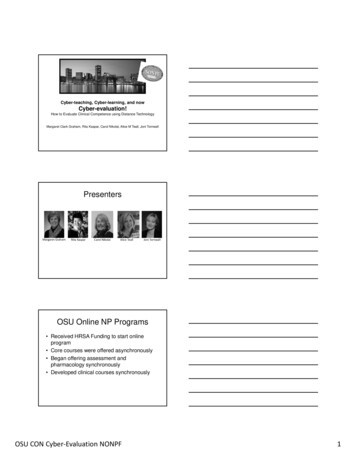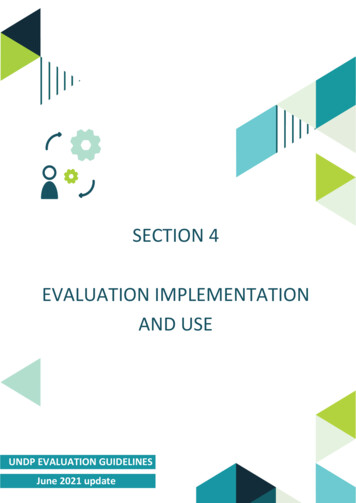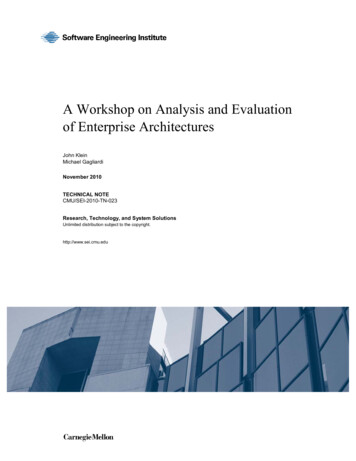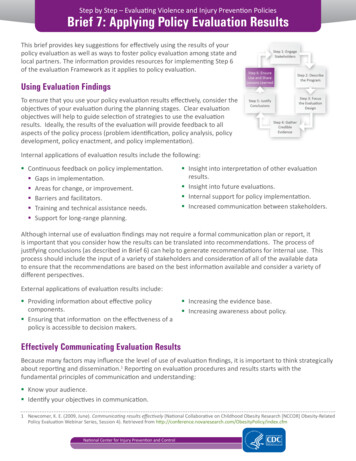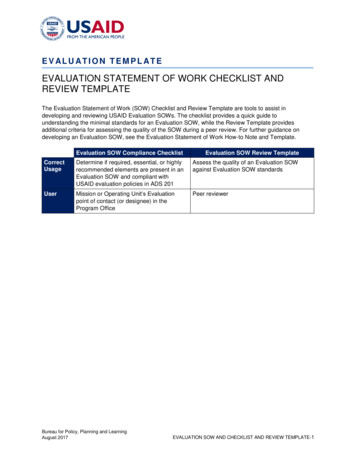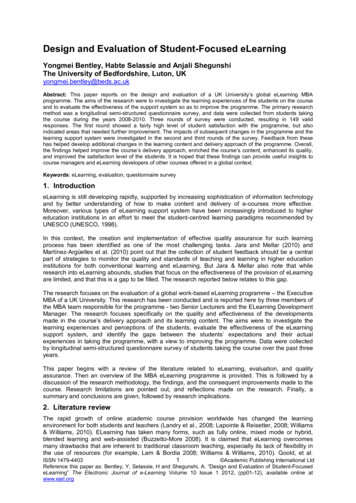
Transcription
Design and Evaluation of Student-Focused eLearningYongmei Bentley, Habte Selassie and Anjali ShegunshiThe University of Bedfordshire, Luton, UKyongmei.bentley@beds.ac.ukAbstract: This paper reports on the design and evaluation of a UK University’s global eLearning MBAprogramme. The aims of the research were to investigate the learning experiences of the students on the courseand to evaluate the effectiveness of the support system so as to improve the programme. The primary researchmethod was a longitudinal semi-structured questionnaire survey, and data were collected from students takingthe course during the years 2008-2010. Three rounds of survey were conducted, resulting in 149 validresponses. The first round showed a fairly high level of student satisfaction with the programme, but alsoindicated areas that needed further improvement. The impacts of subsequent changes in the programme and thelearning support system were investigated in the second and third rounds of the survey. Feedback from thesehas helped develop additional changes in the learning content and delivery approach of the programme. Overall,the findings helped improve the course’s delivery approach, enriched the course’s content, enhanced its quality,and improved the satisfaction level of the students. It is hoped that these findings can provide useful insights tocourse managers and eLearning developers of other courses offered in a global context.Keywords: eLearning, evaluation, questionnaire survey1. IntroductioneLearning is still developing rapidly, supported by increasing sophistication of information technologyand by better understanding of how to make content and delivery of e-courses more effective.Moreover, various types of eLearning support system have been increasingly introduced to highereducation institutions in an effort to meet the student-centred learning paradigms recommended byUNESCO (UNESCO, 1998).In this context, the creation and implementation of effective quality assurance for such learningprocess has been identified as one of the most challenging tasks. Jara and Mellar (2010) andMartínez-Argüelles et al. (2010) point out that the collection of student feedback should be a centralpart of strategies to monitor the quality and standards of teaching and learning in higher educationinstitutions for both conventional learning and eLearning. But Jara & Mellar also note that whileresearch into eLearning abounds, studies that focus on the effectiveness of the provision of eLearningare limited, and that this is a gap to be filled. The research reported below relates to this gap.The research focuses on the evaluation of a global work-based eLearning programme – the ExecutiveMBA of a UK University. This research has been conducted and is reported here by three members ofthe MBA team responsible for the programme - two Senior Lecturers and the ELearning DevelopmentManager. The research focuses specifically on the quality and effectiveness of the developmentsmade in the course’s delivery approach and its learning content. The aims were to investigate thelearning experiences and perceptions of the students, evaluate the effectiveness of the eLearningsupport system, and identify the gaps between the students’ expectations and their actualexperiences in taking the programme, with a view to improving the programme. Data were collectedby longitudinal semi-structured questionnaire survey of students taking the course over the past threeyears.This paper begins with a review of the literature related to eLearning, evaluation, and qualityassurance. Then an overview of the MBA eLearning programme is provided. This is followed by adiscussion of the research methodology, the findings, and the consequent improvements made to thecourse. Research limitations are pointed out, and reflections made on the research. Finally, asummary and conclusions are given, followed by research implications.2. Literature reviewThe rapid growth of online academic course provision worldwide has changed the learningenvironment for both students and teachers (Landry et al., 2008; Lapointe & Reisetter, 2008; Williams& Williams, 2010). ELearning has taken many forms, such as fully online, mixed mode or hybrid,blended learning and web-assisted (Buzzetto-More 2008). It is claimed that eLearning overcomesmany drawbacks that are inherent to traditional classroom teaching, especially its lack of flexibility inthe use of resources (for example, Lam & Bordia 2008; Williams & Williams, 2010). Goold, et al.1 Academic Publishing International LtdISSN 1479-4403Reference this paper as: Bentley, Y, Selassie, H and Shegunshi, A. “Design and Evaluation of Student-FocusedeLearning” The Electronic Journal of e-Learning Volume 10 Issue 1 2012, (pp01-12), available online atwww.ejel.org
Electronic Journal of e-Learning Volume 10 Issue 1 2012(2007) indicate that this type of online learning environment enables a greater number of students ofdiverse educational and cultural backgrounds, as well as of modes of study, to come together withinthe one virtual classroom. However, they warn that many of the clues that help enable staff andstudents to be culturally sensitive in physical classrooms are missing in the online world. For this andother reasons, it has been suggested that students need better preparation for learning in an onlineenvironment than in a traditional classroom.According to Rajasingham (2009) and Guri-Rosenblit (2009), eLearning has evolved from distanceeducation and is still struggling to gain full recognition and accreditation within mainstream educationas an approach for high quality provision. While developments in eLearning have been exciting andbeneficial, finding ways of enhancing the quality of provision and effectiveness have posed a seriouschallenge. In response to this concern of legitimacy, value and quality of online programmes, Davieset al. (2011) develop a model that provides a comprehensive conceptual framework which identifiesthe factors that enhance the quality of fully-online degree programmes. Pillay & Kimber (2011) arguethat globalisation, transnational provision of higher education, and the ‘use of market mechanisms’have increased the complexity in issues of accountability, authority, and responsibility in qualityassurance.Zygouris-Coe, et al. (2009) note that instituting a well-structured quality assurance process can beexpensive and time consuming, but that it can be worth the effort. For example, the study undertakenby Kidney, et al. (2007) supports this. They state that the merit, quality and success of the eLearningprogramme they investigated were mainly due to the proper application of the quality assurancestrategies. Rajasingham (2009) notes that new educational paradigms and models that challengeconventional assumptions and indicators of quality assurance are becoming possible with the help ofthe increasing sophistication in information technology.Deepwell (2007) makes a useful distinction between quality assurance and evaluation, and viewsevaluation as an instrument of quality enhancement rather than quality assurance. Wang (2006)identified learning effectiveness, access, student satisfaction, faculty satisfaction, and costeffectiveness as the five ‘pillars of quality’ of online programmes. However, Martínez-Argüelles, et al.(2010) identify the key quality dimensions - from the student’s point of view - to be the learningprocess, administrative processes, teaching materials and resources.We now turn to evaluation more specifically. Evaluation is defined by Saunders (2003) as the“purposeful gathering, analysis and discussion of evidence from relevant sources about the quality,effectiveness, and impact of provision, development or policy.” (Saunders, 2003: 39). While themeasurement of student feedback is recognised as an important component of quality assurance,there have been mixed reports as to its effectiveness. For example, according to Gur u and Drillon(2009), analysing users' perceptions regarding an eLearning system can provide valuable data toevaluate and improve its functioning and performance. On the other hand, Jara and Mellar (2010)report from their research findings that student feedback was not always fully adequate to supportquality enhancement. So a researcher is cautioned that they will need to make judgements in thisarea, and maybe conduct further research to validate initial findings.Finally, Lapointe & Reisetter (2008) suggest that the new reality of online learning demands areassessment of our understanding of what makes for the most productive student engagement. Thefindings reported below are intended to help move towards an answer to this question.3. Overview of the MBA programmeThe Executive MBA programme discussed in this paper is primarily designed for those with a suitablemanagement background who wish to become more effective and enterprising managers in theknowledge-based global economy. The MBA programme has been delivered for over seven years towork-based eLearning students in the UK and at a number of overseas countries including: Oman,India, Germany, Poland, South Africa and Switzerland. It is delivered mainly online via the UKUniversity’s eLearning learning support system, but also provides periods of face-to-face teaching.Therefore, it is also called a ‘blended-learning’ programme. The face-to-face teaching can be taken atthe overseas counterpart university, or in the UK, or at both. In the cases of the overseas courses,such teaching is delivered by both the ‘flying faculty’ (lecturers from the Business School of the UKuniversity) and by lecturers of the counterpart local universities in partnership with the UK University’scourse leaders. Currently there are about 400 students in total taking the course, of which about 40%www.ejel.org2 Academic Publishing International Ltd
Yongmei Bentley, Habte Selassie and Anjali Shegunshiare based in Oman, 25% in the UK (full-time and part-time students combined), 15% in Poland, 10%in South Africa, and remaining 10% in India, Germany and Switzerland combined.Students on the course are required to take and pass ten course modules to complete the programme– eight taught modules and two applied management projects. It normally takes two years (4semesters) for work-based students to complete the course. The revised course structure of thisprogramme, based in part on the findings from the first and second surveys of this research, consistsof five modules in the first year and five in the second, as follows:Year 1: Leading and Managing People; Accounting for Leaders; Marketing Products and Services in aDynamic Environment; Mobilising Creativity and Innovation; and a Leadership project.Year 2: Strategy; Operations and Project Management; Entrepreneurship and Small BusinessManagement; Thriving in a Competitive Global Context, and an Integrated Management project.Figure 1 shows the main building blocks of the blended-learning system designed for the programme,and demonstrates the range of learning modes that are available to the students.Figure 1: The blended learning structure of the executive MBA programme (Priestman, 2010: 14)At the start of each semester the ‘flying faculty’, with the support of the local institution, conductinduction sessions for the students of each cohort at the overseas centres, and this is followed by twofull days of face-to-face teaching. The main purpose of this approach is to give the students anoverview of each module run in the semester, and a feeling for the level of teaching, and the degreeof response expected of them, throughout the course.The UK lecturers are in charge of preparing and uploading all the online course content, includingPowerPoint slides, relevant articles and papers, links to useful websites, audio and video clips,podcasting clips, assignment instructions, marking and feedback, etc. although tutors from theoverseas partner institutions can also contribute to online material. The latter institutions, with theirsupporting lecturers and teaching facilities, provide face-to-face teaching once a month throughoutthe programme. These institutions also provide the local basic services to meet the requirements ofthe students. In addition, the UK lecturers deliver regular WIMBA (a voice over the Internet system)sessions for each module. WIMBA is a plug-in WebCT Vista which has ‘live classroom’ and ‘voicetools’ components by which the tutor and the students in different locations can hold a virtual classsimultaneously, see each other via the webcam, and talk to each other as in a traditional classroom.WIMBA provides a forum, among other things, for UK lecturers to get a good grasp of the progressthat the students have made via this blended learning approach, answer their questions related to thesubject, and provide additional support for the coursework.www.ejel org3ISSN 1479-4403
Electronic Journal of e-Learning Volume 10 Issue 1 2012Assignments for all modules are delivered to the students online by the UK lecturers, and the studentsare required to submit all their assignments to the UK lecturers via the Turnitin system integrated withthe eLearning support system BREO. The Turnitin system is an online plagiarism checker forstudents’ course assignments, and is an effective means to check the extent to which assignmentssubmitted for the course are written by the students themselves. Examinations are taken andinvigilated at the local institutions, but the scripts are posted to the UK. All assignments andexamination scripts are marked by the UK lecturers.4. Methodology: Semi-structured questionnaire surveyThe primary research approach adapted for this study is a longitudinal survey (Dillon et al., 1987),using a semi-structured questionnaire to collect data from respondents over time. This involved threerounds of surveys conducted across selected course sites at different points in time, thus enablingexamination of the changes that occurred in the attitudes and satisfaction levels of the students. Thefirst survey round covered four sites – Oman, India, UK, and Poland, and was carried out from April toJuly 2008. The second round covered two sites - Oman and India, and took place from January toMarch 2009. The third covered Oman, UK and Germany and was undertaken from June to December2010. The survey forms were sometimes delivered online, and sometimes handed out in class,depending on what was most convenient. The split of survey respondents by country and by period isgiven in Table 1. There were 149 valid responses in total, with two thirds of these from the Oman site,which, as mentioned earlier, has had the largest student population on the programme.Table 1: Summary of survey respondents by country (N 149)Country1st Survey (2008)No. of% ofresponses responses2nd Survey (2009)No. of% ofresponses responses% of3rd Survey (2010)responsesNo. of% ofTotalresponses responses responses by 9100%10025105914967%17%7%3%6%100%A number of pragmatic considerations led to the changes in choice of survey sites over the course ofthe surveys. These included dates and times when the courses were offered; accessibility of thestudents; and, on occasion, the availability of a researcher being available to deliver and collectsurvey forms. This impacted, to some extent, the comparability of data between sites and over timeperiods. However it was felt on balance that there was enough continuity between sites, and studentcohorts, for useful comparison to be drawn.5. Data analysis and discussion of key issuesIn higher education, evaluation can cover many aspects, such as programme design, adequacy ofresources, performance of students, and of lecturers, effectiveness of policies, etc. For evaluating thisblended-learning MBA programme, the evaluation process was designed to measure and improve thequality and effectiveness of technology-enhanced teaching, and the learning experience of the course.The investigation focussed specifically on the areas of course management, learning and teaching,online learning content, assessment, the learning support systems in place, and students’ overallexperience of taking this course. These areas were seen as key for measuring the quality of theprogramme as provided to the students. In particular, as the focus was on improvement in coursecontent and provision, the outcomes of such changes themselves needed evaluation. For this reasonthe second and third survey rounds contained a number of different questions from the first. This wasto take into consideration the findings from the first survey, as well as the changes that had beenmade to the MBA programme as a result of these findings.5.1 The first surveyFor the first survey round, as Table 1 shows, 63 completed questionnaires were received from fourMBA centres - Oman, India, UK and Poland. The students in Poland and UK completed the surveyonline; while those in Oman and India completed it off-line, with the lecturers directly handing thewww.ejel.org4 Academic Publishing International Ltd
Yongmei Bentley, Habte Selassie and Anjali Shegunshiquestionnaire to the students and collecting it on the same day. The latter process contributed to ahigher rate of returns from these centres. An overview of the perceptions of the respondents for thisfirst survey round is given in Table 2.Table 2: Results from the first survey (% response by category)Survey ItemsQ1 Registration processExcellentGoodAveragePoor% (E&G) % (A&P)315511386142Teaching at Induction206016480203Teaching at local institution185824076244Module Handbooks224727469315Local Tutor support154533760406Module information from local institution96722276247Local support facilities951261460408Textbook availability1833222751499Usefulness of CD ROMS20442214643610 Quality of CD ROM materials2058202782211 Reading materials on BREO2638279643612 Learning resources/weekly online22452211673313 UK Lecturer support1151335623814 Slides on BREO2544256693115 Audio/video clips3452131485216 Relevant website links15432913584217 Voice Café11262538376318 Course/module response247429495119 IT training and support11354212465420 Assignment instructions1653274693121 Assignment submission procedures16551316712922 Assignment feedback15362920514923 Referral procedure1357237703024 Failure procedures18391726574325 Academic offence procedures16441624604026 Social networking opportunities9383320475327 Overall experience with the tutors2451232752528 Overall experience of online supportOverall experience of undertaking the29 blended learning MBAAverage:849367574320164647292551266346337The results in this table are self-explanatory. Overall, the survey results showed a fairly high level ofsatisfaction with the MBA programme, with an average of 63% of the respondents perceiving theaverage of the 29 aspects of the course measured as being either ‘excellent’ or ‘good’, versus 25%perceiving this average as ‘average’, and 12% as ‘poor’. In terms of the service quality as perceivedby the students, 22 out of the 29 aspects surveyed showed a combined percentage of ‘excellent’ and’good’ (‘% E&G’ in Table 2) to be greater than the combined percentage of ‘average’ and ’poor’ (%A&P). Six results had these percentages about the same (questions 8, 15, 18, 19, 22, 26), and one(question 17, on Voice Café) had this percentage significantly reversed (37% versus 63%).As this was a semi-structured questionnaire survey, the respondents were given the opportunity tooffer comments where appropriate in order to provide more detailed information on the topic areasbeing investigated, and to encourage suggestions for improving the course content, deliveryapproach, and support systems. Examples of positive comments included:‘Voice over the Internet, Blackboard, and the student records system are excellentfacilities for remote students like us. I found this course very balanced and suitable forworking candidates’.www.ejel org5ISSN 1479-4403
Electronic Journal of e-Learning Volume 10 Issue 1 2012‘I was impressed with the free wireless Internet facility and the ever-helpful nature of thefaculty office and administration team’.‘It has been really a correct decision for me to enrol onto the MBA programme. Thewisdom I derived from [taking this] e-MBA is tremendous’.‘It was a pleasure and enjoyable experience taking the MBA with this UK University’.Not surprisingly, there was also a range of negative comments, and the ratio of positive to negativecomments was about three to two. To put these comments into context it needs to be borne in mindthat the students were mostly at middle and senior-level management in full-time employment, andwere working on the Executive MBA often on day or week release schemes from their employer, andat weekends. As a result, student expectations of the course were generally high, and the timepressure on the students was often quite onerous.The following are examples of some of the criticisms from respondents: Many respondents asked for more consistent and comprehensive module information andguidance, clearer assignment instructions, and for the formats of examinations. Some mentionedthat they had a desire to have all the essential information about the course issued at theinduction sessions (rather than having some information fed piecemeal later). Some felt that BREO had been under-used, e.g. it was not used to provide effective discussionforums. A few respondents expressed a dislike for the different assignment submission systems used ondifferent courses within the MBA, as these were often seen as time-consuming and confusing. Some felt very dissatisfied if they failed to receive their assignment feedback within the specifiedtime, but appreciated the cases where more detailed and customised feedback had been given,rather than just a brief and general comment, as they wanted to understand what was wrong intheir work. They also had a desire for quicker responses to requests for information and feedback. Some felt the need to spend more time with the UK-based tutors, and expressed a wish for anadditional round of face-to-face interaction in the middle of a semester from the UK courseleaders. Some would have liked to gain the opportunity for the classroom experience at the UKUniversity. In addition, it was suggested that the communication and collaboration between the educationpartners be improved, so that better and more effective on-line support can be provided.Overall, the above comments could be summarised as indicating a need for more support for thestudents’ independent learning process. As can be seen from Table 2, the average of positiveresponses (‘excellent’ plus ‘good’) on support for eLearning itself (questions 4, 6, 10, 12, 20, 21) wasreasonably high. Nevertheless, the perceptions of individual students showed that there was still roomin a number of areas for the university to make improvement. Suggestions from the above research,together with additional feedback collected from consultation with both the UK and local staff, wereconsidered in detail, and subsequently, a significant range of changes to the programme were made.Some of these are discussed in the following section.5.2 The second and third surveysSubsequent to the changes made after the first survey round carried out early in 2008, a secondsurvey round was conducted in 2009 covering two overseas sites: Oman and India. This survey had28 questions of which 19 were the same as those in the first survey. Thirty-seven valid responseswere received. The primary purpose of this second round was to measure any improvement (orotherwise) resulting from the course changes, and to uncover additional issues. A comparisonbetween all the three rounds of surveys is given in Table 3. (For consistency, question numbersmatch those of Table 2.)An examination of the results from the first two survey rounds showed that 14 out of the 19 topicareas investigated in common across the two surveys had improvements in the second survey in the‘positive’ response category (i.e., % of ‘excellent’ plus ‘good’), with nine areas showing a gain of 10%or more. Significant improvements included: teaching at induction by the UK ‘flying faculty’; thequality of module handbooks; UK tutor support; audio/video clips; ICT training and support; socialnetworking opportunities; overall experience of online support; and the overall experience ofwww.ejel.org6 Academic Publishing International Ltd
Yongmei Bentley, Habte Selassie and Anjali Shegunshiundertaking the MBA (where the latter response rose from 66% to 79% in the ‘E&G’ category). Inaddition, the percentages in the ‘E&G’ category for both Question 10 (the change from providing‘learning materials on CD Rom’ in the first survey to providing ‘weekly online material’ in the second),and Question 17 (the change from using ‘Voice Cafe’ for Internet conference in the first survey to theadoption of ‘WIMBA’ in the second), rose from 64% to 73% and from 37% to 85%, respectively, afterthe changes were made.Table 3: Comparison of equivalent questions from all three surveys (% response by category)However, it was surprising to see that in spite of the effort made for improvement after the first surveysome areas did worse, including teaching by local institutions, and the referral procedure and thefailure procedure. This indicated that further effort was needed to improve the experience of thestudents, though in part it might be that later students were more demanding, especially for servicesrelated to certain university procedures. Overall, the average percentage of respondents who ratedthe course as ‘excellent’ and ‘good’ on the topics included in this comparison improved from 63% inthe first survey to 74% in the second. This was seen as a very encouraging finding, and justified theextensive work by all the parties involved to improve the design and provision of the course.Note that other questions in the second survey were different from those in the first as many changeshad been made in various aspects of the course after the first survey, and questions on thesechanges were incorporated in second survey to examine the impacts on the students’ learningexperience. For example, more informative and meaningful module handbooks and ICT trainingguides were introduced, and questions related to these changes were added.Some of the more significant changes that had been made to the programme following the first surveyare discussed below, set against the findings from the two surveys to indicate how the gainsmentioned above in student satisfaction were achieved.The introduction of WIMBA: WIMBA was adopted since August 2008 to replace the Voice café system(voice over the Internet). WIMBA is an audio component to Blackboard courses enabling users towww.ejel org7ISSN 1479-4403
Electronic Journal of e-Learning Volume 10 Issue 1 2012record voice announcements and audio blogs, send email messages with embedded audio, andconduct live voice chat sessions. One student commenting on this after a WIMBA session said that “itis the best teaching session after the induction”. Regarding the WIMBA live classroom, the surveyshowed that the respondents who responded in the ‘excellent’ and ‘good’ categories were over 50%,and 30%, respectively. The students also liked the idea of archiving the WIMBA sessions as anadditional eLearning resource, as it allows students (such as those who have missed a class) to seethe archived files. BREO tracking statistics showed that for the seven WIMBA archives which weremade available for one cohort of students during March 2009, there were 107 hits, which indicatedthat the students appreciated the effort the university had made to provide this facility. Mostrespondents considered WIMBA as the better eLearning supporting system, as the second surveyshowed that the students’ perception of WIMBA was significantly more positive than that for VoiceCafé (85% versus 37%).Improved course delivery approach: A significant change made in the blended learning supportsystem for the MBA programme was the restructuring of the format and timing of the online learningcontent. This was changed so that all content was presented online in a standard format, and madeavailable weekly consistent with the learning schedule. This represented a significant changecompared to the previous system where the key course material was provided on a CD for eachmodule. In comparing the two elements (provision of CD ROMs versus material online weekly), thepercentage of students viewing course provision as being ‘excellent’ plus ‘good’ increased from 64%to 73%. The respondents also liked the audio and video clips prepared by the UK tutors on specifictopics, and 80% wished to have more such clips for each of the modules.Improved course and module information: In the first survey, students expressed their wish that eachmodule handbook provide all the information about the module, in particular, including details aboutthe exams and assignments, and examples of good assignments. The format of all the modulehandbooks were therefore expanded and standardized, and as a result the students reported thatthey were clearer about requirements for assignments in each module that they took. In terms ofresponse to the questionnaire, the positive response level for this area improved from 69% to 81%.Provision of online training materials: Subsequent to the first survey, a range of training materials,including an ICT guide and audio/video clips for using the university’s digital library were developedand made available online to the students. As a result, in the second survey the students rated theMBA ICT guide, the WIMBA live classroom guidelines, the clips on digital library, and the Harvardreferencing guidelines, as the most useful tools, followed by the guide for using Net-mail (the emailing system for students). Overall, the survey evaluation o
eLearning" The Electronic Journal of e-Learning Volume 10 Issue 1 2012, (pp01-12), available online at www.ejel.org . by Kidney, et al. (2007) supports this. They state that the merit, quality and success of the eLearning programme they investigated were mainly due to the proper application of the quality assurance strategies. Rajasingham .



